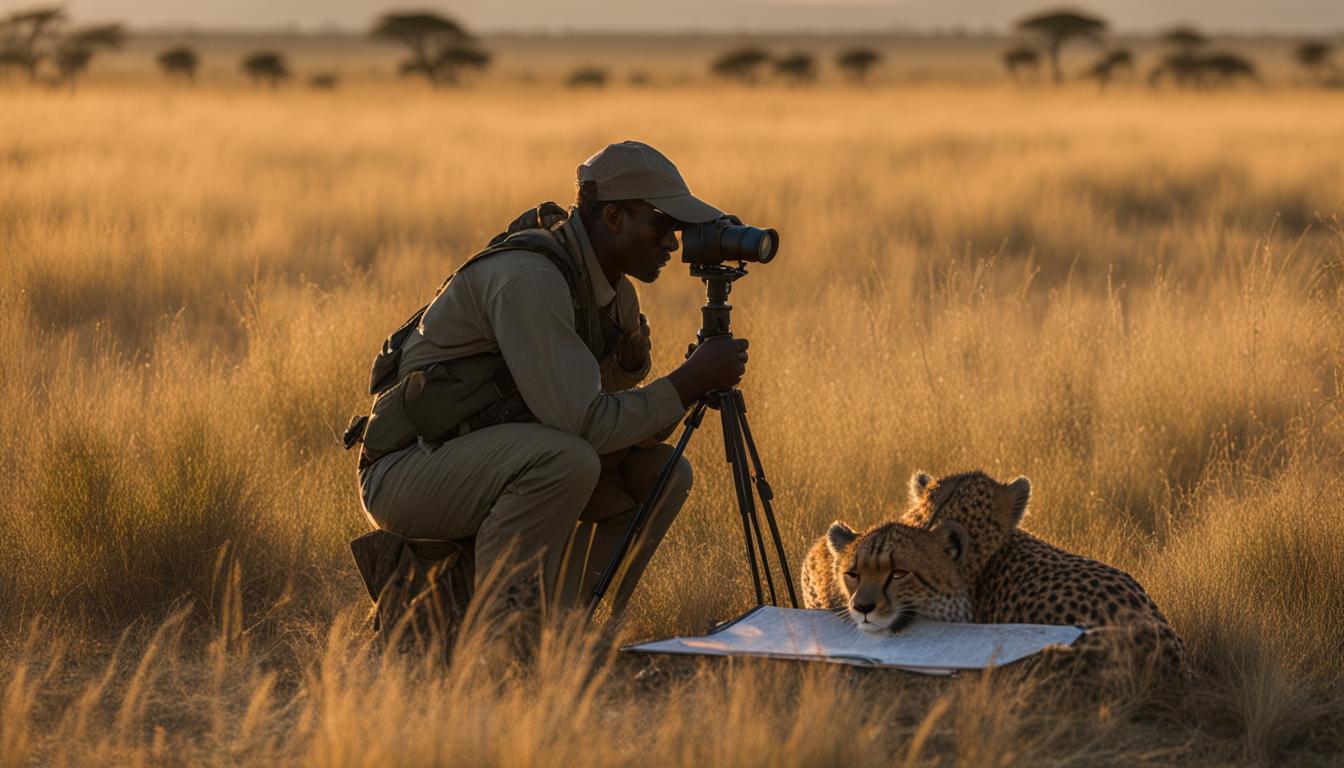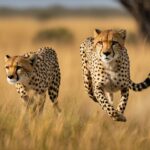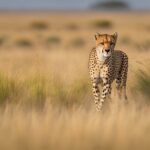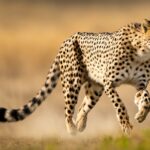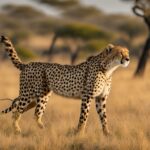Research plays a pivotal role in understanding and conserving wild cheetah populations. Through various techniques and methodologies, researchers delve into the world of cheetahs to uncover the secrets of their behavior and biology. From tracking their movements to studying their genetics, cheetah research offers valuable insights into the lives of these incredible creatures.
Tracking cheetahs in the wild is a fundamental aspect of research. By using innovative tracking methods, scientists can monitor their movements and gain a deeper understanding of their behavior. This knowledge not only sheds light on their hunting strategies and territorial habits but also helps researchers assess the impact of human-wildlife interactions on cheetah populations.
Studying the genetics of cheetahs is another vital component of research. By analyzing their DNA, scientists can uncover important information about the cheetah’s population structure, genetic diversity, and potential inbreeding issues. This knowledge is crucial for developing effective conservation strategies and ensuring the long-term survival of the species.
The Role of Genetics in Cheetah Research
In the field of cheetah research, genetics plays a fundamental role in understanding and conserving wild cheetah populations. By studying the cheetah’s genetic makeup, researchers can gather crucial insights into their population dynamics, genetic diversity, and potential threats they face. Through genetic analysis using microsatellite markers, individual cheetahs can be identified, allowing for accurate population monitoring and the assessment of genetic health. This information is vital for developing effective conservation strategies and ensuring the long-term survival of cheetahs in their natural habitats.
The Cheetah Conservation Fund (CCF) in Africa is at the forefront of cheetah genetics research. Led by Dr. Anne Schmidt-Küntzel, the CCF’s genetics laboratory utilizes advanced techniques to analyze DNA samples and uncover vital information about cheetah populations. Notably, the laboratory uses confiscated cheetah cub DNA to combat the illegal wildlife trade. By identifying the genetic origins of these cubs, researchers can better understand the trade routes and develop strategies to reduce trafficking.
“The study of cheetah genetics provides us with valuable insights into the species’ conservation needs,” says Dr. Schmidt-Küntzel. “Understanding their genetic diversity and population dynamics helps us take the necessary steps to protect and preserve these magnificent creatures.”
The importance of genetic research in cheetah conservation cannot be overstated. It allows researchers to assess the health and viability of populations, identify potential risks, and develop targeted conservation plans. By focusing on genetics, we can ensure the long-term survival of cheetahs and contribute to the overall biodiversity and ecological balance of their habitats.
Cheetah Genetics Research: Key Findings
| Area of Study | Key Findings |
|---|---|
| Population Dynamics | Genetic analysis helps monitor population size, structure, and connectivity between subpopulations, aiding in conservation efforts. |
| Genetic Diversity | Assessing genetic diversity is crucial for understanding the health and adaptability of cheetah populations, allowing researchers to identify potential inbreeding issues. |
| Illegal Wildlife Trade | Confiscated cheetah cub DNA provides valuable information about the origins and routes of the illegal wildlife trade, aiding in combatting trafficking. |
| Conservation Strategies | Genetic data guides the development of targeted conservation plans, including habitat protection, reintroduction programs, and minimizing human-wildlife conflicts. |
Cheetah Tracking Methods and Population Studies
Population studies and monitoring are fundamental for understanding the dynamics of cheetah populations and implementing effective conservation strategies. By employing various tracking techniques and collecting valuable data on population demographics, researchers can gain insights into cheetah behavior and habitat utilization.
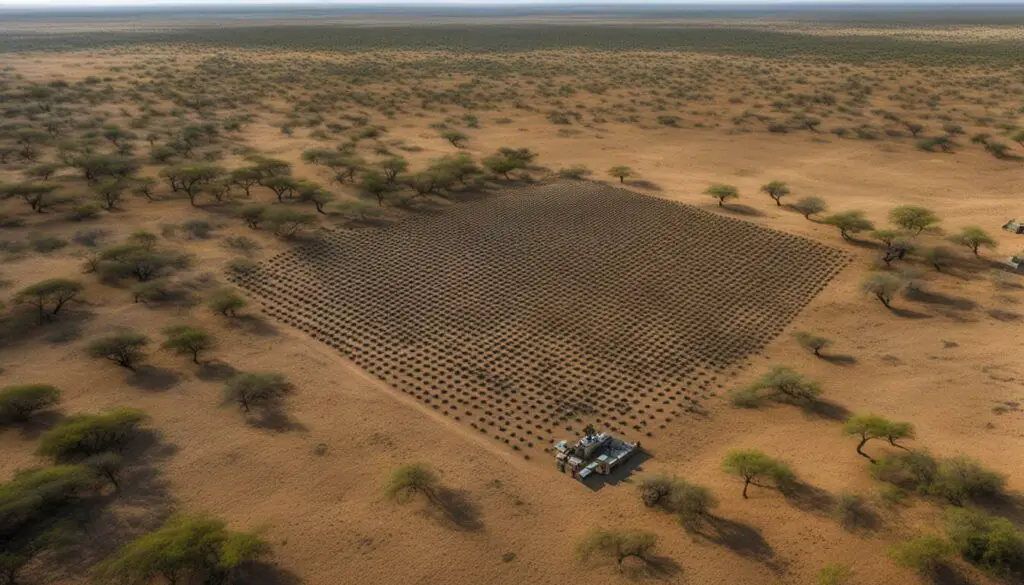
One of the key methods used in cheetah tracking is the utilization of scat detection dogs. These specially trained canines assist researchers in locating and identifying cheetah scat, which provides valuable information about individual cheetahs and their movements. By analyzing scat samples and combining it with genetic analysis, researchers can track the population size, genetic diversity, and assess the overall health of cheetah populations.
To further enhance the understanding of cheetah populations, telemetry tracking equipment is also utilized. This technology allows researchers to track cheetah movements in real-time, enabling them to unravel patterns related to habitat utilization, migration, and the impact of human-wildlife conflict.
Population Monitoring Table
| Tracking Techniques | Advantages | Limitations |
|---|---|---|
| Scat detection dogs | – Efficient in locating cheetah scat – Provides valuable genetic information – Non-invasive method |
– Requires well-trained dogs – Limited in tracking real-time movements |
| Telemetry tracking equipment | – Provides real-time data on cheetah movements – Helps understand habitat utilization – Enables assessment of human-wildlife conflict impacts |
– Expensive equipment – Limited to cheetahs wearing collars |
By combining these tracking methods, researchers can gain comprehensive insights into cheetah populations, their behavior, and the challenges they face. This knowledge is crucial for developing effective conservation strategies, managing human-wildlife conflict, and ensuring the long-term survival of these magnificent creatures.
Investigating Human-Wildlife Conflict
Understanding and mitigating human-wildlife conflict is a crucial aspect of cheetah research. By addressing the concerns of farmers and finding practical solutions, researchers aim to reduce conflicts and promote coexistence between humans and cheetahs. One effective approach is the development of non-lethal predator control methods that minimize the loss of livestock and reduce the indiscriminate removal of cheetahs.
Farmers collaborate with organizations like the Cheetah Conservation Fund (CCF) to implement these methods. One such method is the use of non-lethal deterrents, such as Foxlights and Skaapwagters. These devices create the illusion of human presence, deterring cheetahs and other carnivores from approaching livestock enclosures. By installing these deterrents in strategic locations, farmers can protect their livestock without resorting to lethal measures.
Additionally, livestock guarding dog programs have yielded promising results in reducing predator attacks. Specially trained dogs are placed with farmers to protect livestock and deter cheetahs from approaching. These dogs form a bond with the livestock, providing round-the-clock protection and minimizing the risk of encounters between farmers and cheetahs. This program not only safeguards livestock but also reduces the need for lethal control methods, benefiting both farmers and cheetah populations.
| Predator Control Method | Advantages |
|---|---|
| Non-lethal deterrents (e.g., Foxlights, Skaapwagters) | – Minimizes loss of livestock – Reduces conflicts between farmers and cheetahs – Preserves cheetah populations |
| Livestock guarding dog programs | – Provides round-the-clock protection – Reduces predator attacks on livestock – Promotes coexistence between farmers and cheetahs |
By implementing these non-lethal methods and programs, researchers and farmers can work together to find viable strategies that protect both livelihoods and cheetah populations. This collaborative approach not only helps mitigate human-wildlife conflict but also fosters a greater understanding and appreciation for these magnificent creatures.
The Importance of Ecological Research and Conservation
Ecological research plays a pivotal role in understanding the intricate relationships between cheetahs and their environment. By monitoring various ecological factors, researchers gain valuable insights into the health of cheetah habitats and the biodiversity within them. This knowledge is crucial for developing effective conservation strategies that protect both cheetah populations and the ecosystems they inhabit.
One important aspect of ecological research is the study of wildlife corridors. These corridors are essential for maintaining connectivity between protected areas, allowing cheetahs and other wildlife to move freely and access vital resources. By understanding the importance of these corridors, researchers can advocate for their conservation and work towards creating and preserving these crucial links.
Habitat restoration is another key focus of ecological research. By studying vegetation, prey base, and habitat use by game species, researchers can assess the ecological health of cheetah habitats and identify areas in need of restoration. Restoring degraded habitats not only benefits cheetah populations but also promotes overall biodiversity and creates sustainable ecosystems.
| Ecological Research and Conservation Efforts | Key Benefits |
|---|---|
| Monitoring wildlife corridors | Ensuring connectivity and movement of cheetah populations |
| Studying habitat restoration | Enhancing biodiversity and creating sustainable ecosystems |
| Protecting prey base | Ensuring adequate food sources for cheetahs |
“Ecological research is crucial for understanding the impact of cheetahs on their environment and vice versa. It allows us to make informed decisions about conservation strategies and ensure the long-term survival of these magnificent creatures.”
Conservation efforts informed by ecological research also focus on protecting the prey base for cheetahs. By monitoring and managing the populations of prey species, researchers can ensure an adequate food supply for cheetahs and maintain the delicate balance of predator-prey relationships within their ecosystems.
By recognizing the importance of ecological research and incorporating it into conservation efforts, researchers and conservationists strive to safeguard not only the iconic cheetah but also the diverse ecosystems they rely on. Through ongoing research and collaborative conservation strategies, we can secure a future where cheetahs thrive and coexist harmoniously with their environment.
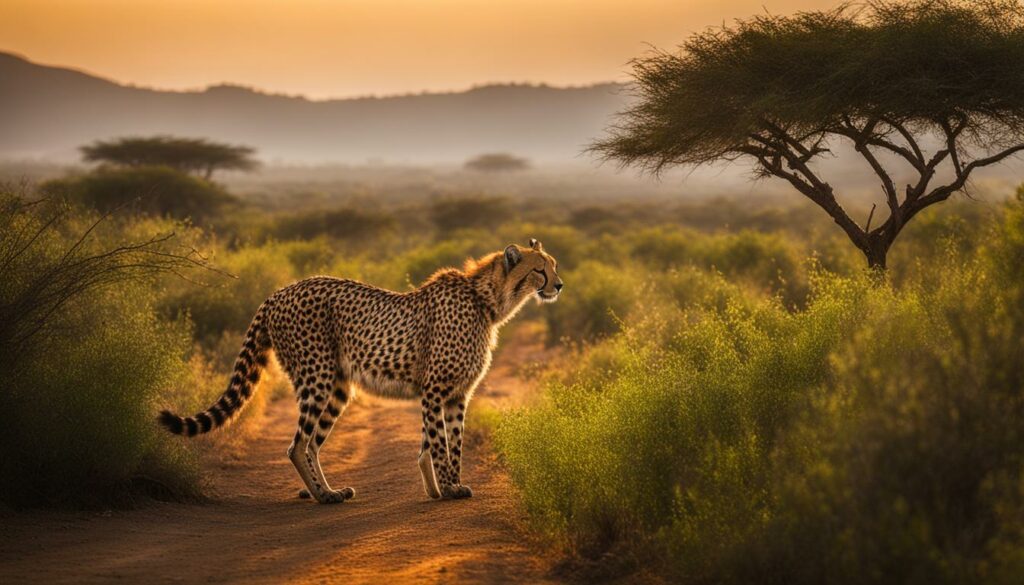
Conclusion
Research collaborations and conservation strategies are key in protecting cheetah populations and their habitats. Through the study of genetics, tracking movements, investigating human-wildlife conflict, and conducting ecological research, valuable data is gathered to inform conservation efforts. By working together, organizations, scientists, and local communities can develop effective strategies to ensure the long-term survival of these magnificent creatures.
Cheetah conservation is a collective effort that requires cooperation and support from various stakeholders. By joining forces, researchers can develop comprehensive conservation plans that address the threats faced by cheetahs, such as habitat loss, poaching, and human-wildlife conflict. Through research collaborations, knowledge and resources are shared, leading to more impactful conservation outcomes.
Conservation strategies aim to protect cheetah habitats and promote coexistence between humans and cheetahs. By understanding the factors that contribute to conflicts, such as livestock predation, researchers can develop practical solutions that minimize the loss of both human livelihoods and cheetah lives. The use of non-lethal deterrents, livestock management techniques, and livestock guarding dogs can help mitigate conflicts and foster harmonious relationships between communities and cheetahs.
Ultimately, the goal of cheetah research is to ensure wildlife protection. By studying these magnificent creatures and their ecosystems, researchers gain insights into the intricate dynamics of cheetah populations. This knowledge is essential for implementing effective conservation measures and safeguarding the future of cheetahs for generations to come.
What methods do researchers use to study and track wild animal populations?
Researchers employ various methods for studying wild chimpanzee populations. These methods include camera traps, GPS tracking collars, and behavioral observations. By using these techniques, researchers can gain valuable insights into the behaviors, movements, and population dynamics of wild chimpanzees, ultimately aiding in their conservation.
Do Researchers Use Similar Methods to Track and Study Cheetah and Leopard Populations in the Wild?
Yes, researchers use similar methods to track and study cheetah and leopard populations in the wild. Both species are monitored using camera traps, GPS collars, and genetic analysis to gather data on their movements, population sizes, and behaviors. This helps conservationists better understand and protect leopards in the wild.
FAQ
How do researchers track and study wild cheetah populations?
Researchers employ various techniques and methodologies such as cheetah tracking, genetic analysis, scat detection, telemetry tracking, and visual identification to track and study wild cheetah populations. These methods help gather data on cheetah behavior, population dynamics, habitat utilization, and the impact of human-wildlife conflict.
What is the role of genetics in cheetah research?
Genetics plays a vital role in cheetah research. Genetic analysis using microsatellite markers helps researchers identify individual cheetahs, monitor population dynamics, and assess genetic diversity. Understanding the genetic makeup of cheetahs is crucial for conservation efforts, as it helps identify issues such as inbreeding and aids in combating the illegal wildlife trade.
How do researchers track cheetah populations?
Researchers track cheetah populations through various methods, including the use of telemetry tracking equipment and scat detection dogs. Telemetry tracking allows researchers to determine movement patterns and habitat utilization, while scat detection dogs help identify individual cheetahs and assess population structures. These tracking methods provide valuable insights into cheetah demographics and behavior.
How do researchers investigate human-wildlife conflict?
Researchers collaborate with farmers to develop non-lethal predator control methods that minimize livestock loss and reduce conflicts with cheetahs. Deterrents like Foxlights and Skaapwagters are used to protect livestock, and specially trained livestock guarding dogs are placed with farmers to mitigate predator attacks. By addressing the concerns of farmers and finding practical solutions, researchers aim to reduce human-wildlife conflict and promote coexistence between humans and cheetahs.
What is the importance of ecological research in cheetah conservation?
Ecological research helps understand the impact of cheetahs on their environment and vice versa. Monitoring vegetation, prey base, and habitat use by game species helps assess the ecological health of cheetah habitats. Additionally, studying wildlife corridors and biodiversity in non-protected areas aids in maintaining connections between protected areas for cheetah movement. By studying and conserving the broader ecosystem, researchers ensure the long-term survival of cheetah populations.
How do research collaborations contribute to cheetah conservation?
Research collaborations between organizations, scientists, and local communities are vital for the success of cheetah research and conservation efforts. By pooling resources, sharing knowledge, and working together, researchers can develop effective conservation strategies, protect cheetah habitats, and promote coexistence between humans and cheetahs. These collective efforts play a crucial role in preserving cheetah populations for future generations.

